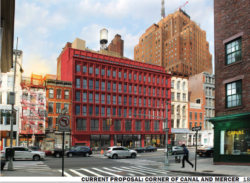
Rendering of 312 to 322 Canal Street in Manhattan. Image: LPC.
Proposal, whose previous iteration was subject to community and commissioner opprobrium, approved after reduction in size and modifications in design and materials. At its meeting on January 23rd, 2017, the Landmarks Preservation Commission considered and approved a modified proposal to redevelop five properties in the Tribeca East Historic District at 312 to 322 Canal Street with a single new structure. The site is currently occupied by two-story commercial structures dating to the 19th century, but heavily altered and reduced in size from their original four stories. The buildings to be demolished were not identified as having a distinct style in the 1992 designation report, and are thought to retain little, if any, original fabric.
An initial proposal was presented to Landmarks on June 6, 2017, for a nine-story brick-faced development.
At the 2017 hearing, opposition to the proposal was voiced by Manhattan Community Board 1, elected officials, and area residents. Opponents objected to the demolition of five buildings that contributed to the area’s history and character, and the size, scale, and design of the proposed development. The applicants were also criticized for their history of illegal work.
Commissioners were also critical, finding the proposal out-of-scale for the location, and the design “monotonous.” The applicants were told that a significant rethinking of the application would be required for approval. Commissioners who broached the issue of demolition found it potentially acceptable.
Grayson Jordan, of Paul A. Castrucci Architect, presented the revised plan, which reduced the height to seven stories, pushed back a stair tower, and replaced brick cladding with terra cotta. Storefronts and fenestration patterns were also modified. The building, planned for residential use with ground-floor retail, would be 76-and-a-half feet high at the streetwall, with an additional setback story. Jordan said the revised proposal fell within contextual building heights. At the streetwall, the building would be the fourth-highest on the block. The applicants also found precedents for wide facades in the district, and drew lessons from their cast iron architecture for the depth and rhythm of the proposal’s facade.
Jordan said Canal Street was “a unique transition zone,” moderating between different architectural traditions and scales. He said the design was inspired by the area’s cast-iron typologies, as well as the utilitarian structures that stood on the site, and was intended to fit into the “hodge-podge” nature of the commercial thoroughfare. The facade would have different depth, with a maximum of 15 inches. Jordan stated that the designers drew lessons from historic cast-iron building in adding visual interest through the interplay of light and shadow.
The terra cotta facade was intended to recall both the cast-iron facade arrangements and the masonry building of the historic district. Terra cotta panels would be glazed to different tones to bring visual variety to the facade. The ratio of masonry to glass would increase as the building ascended. Visible sidewalls would also be faced in terra cotta
The facade would have a maximum depth of 15 inches, intended to hearken to cast-iron facades, and facilitate an interplay of light and shadow. The commercial storefronts at the base, which, in the previous proposal, had been criticized as being reminiscent of a shopping mall by Chair Meenakshi Srinivasan in the previous proposal, would be divided into three bays, rather than the building-spanning glass base proposed earlier. The storefront would be broken up by terra cotta columns, and set in to the building deeper than the facade above, and topped with a projecting cornice.
The penthouse story would be set back seven feet from the streetwall facade, and visible from street vantages.
Commissioner Michael Devonshire expressed concern about the glazed terra cotta, saying a matte finish would be more appropriate. Commissioner Fred Bland determined that the vocabulary and scale of the revised design was appropriate for the district, even if some aspects were “troubling” from an urbanistic perspective. Commissioner Michael Goldblum found an eight-foot setback at the penthouse insufficient, saying, if visible, it should read as a receding rooftop accretion. Commissioner Jeanne Luttfy found the applicants to have responded perceptively to commissioner comments in creating the revise plan, and praised the use of materials.
Chair Meenakshi Srinivasan said the applicants faced a significant challenge in designing a plan for the shallow lot that was efficient and code compliant with marketable floorplates. Srinivasan said that bringing the building down to a contextual scale, design modifications to the storefronts, and relocating the core away from the streetwall had made for an appropriate plan. She concurred with other commissioners that the glazing was “a mistake.” Srinivasan opined that the proposal would be better if the penthouse were set back even further.
Srinivasan found consensus among commissioners to go forward with approval, while directing the applicants to work with Commission staff to reduce or eliminate glazing, and explore further reduction in the penthouse story’s visibility.
Commissioner voted unanimously to issue a modified Certificate of Appropriateness.
LPC: 312-322 Canal Street, Manhattan (19-4744) (Jan. 23, 2017) ((Architect: Paul A. Castrucci, Architect).
By: Jesse Denno (Jesse is a full-time staff writer at the Center for NYC Law).

